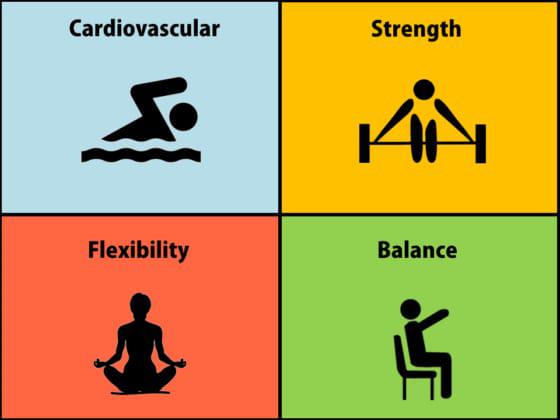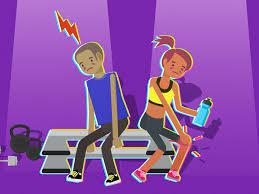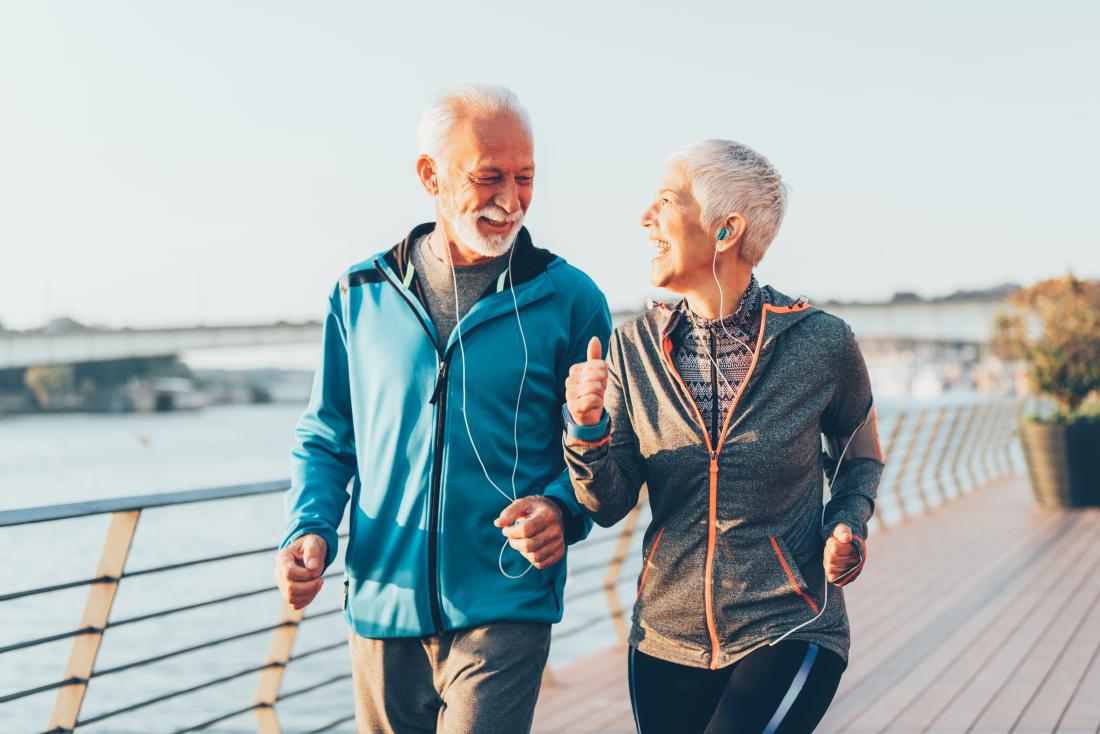Exercise Is Medicine- Being Active For A Better Life
The three major factors that influence our health and longevity are genetics, the environment, and behavior. Because we have very little control over genetic factors, it is critical that we focus on the environmental and behavioral factors we can control to improve health. Where as great strides have been made in reducing the environmental factors influencing diseases, such as through vaccinations, hygiene, and safety regulations, little has been done to target behavioral factors such as physical inactivity. It is tragic that so little has been done to address the one major factor affecting our health and longevity that is almost entirely under our control. At this point in time, physical inactivity has become the greatest public health problem of our time, and finding a way to get patients more active is absolutely critical to improving health and longevity in the 21st century. The beneficial relationship between exercise and health has been well known dating back to the 5th century BC when Hippocrates said that “Eating alone will not keep a man well; he must also take exercise. For food and exercise… work together to produce health”.1 This relationship has been further defined by years of scientific research that shows a clear correlation between physical activity and health status. That is, those individuals who maintain an active and fit way of life live longer and healthier lives than those who do not. This association between physical activity and health persists in virtually every subgroup of the population, regardless of age, sex, race, or environmental condition. Despite the health benefits of regular physical activity and the consequences of a sedentary lifestyle: THE BENEFITS: Many research studies have shown the benefits of regular physical activities. The US Federal Physical Guidelines and many studies show that 150 minutes per week of moderate-intensity physical activity is required to achieve these health benefits. Research shows that a low level of physical activity exposes a patient to a greater risk of dying than does smoking, obesity, hypertension, or high cholesterol, and for older men, regular physical activity can decrease the risk of death by 40%. •Active individuals in their 80s have a lower risk of death than inactive individuals in their 60s. •Regular physical activity can: • Reduce mortality and the risk of recurrent breast cancer by approximately 50%. • Lower the risk of colon cancer by over 60%. • Reduce the risk of developing Alzheimer’s disease by approximately 40%. • Reduce the incidence of heart disease and high blood pressure by approximately 40%. • Lower the risk of stroke by 27%. • Lower the risk of developing type II diabetes by 58% • Be twice as effective in treating type II diabetes than the standard insulin prescription and can save $2250 per person per year when compared to the cost of standard drug treatment. • Can decrease depression as effectively as Prozac or behavioral therapy. • Adults with better muscle strength have a 20% lower risk of mortality (33% lower risk of cancer-specific mortality) than adults with low muscle strength. • A low level of fitness is a bigger risk factor for mortality than mild-moderate obesity. It is better to be fit and overweight than unfit with a lower percentage of body fat. • Regular physical activity has been shown to lead to higher SAT scores for adolescents. • In an elementary school setting, regular physical activity can decrease discipline incidents involving violence by 59% and decrease out of school suspensions by 67%. Types of Physical Activities and Their Effects on Physical Fitness Clinical Features Suggesting High Risk for Physical Activity The physical activity readiness questionnaire for everyone (2020 PAR-Q +) is available at https://www.acsm.org/docs/default-source/files-for-resource-library/par-q-acsm.pdf This questionnaire will tell you whether it is necessary for you to seek further advice from your 0doctor or a qualified exercise professional before becoming more physically active. Recommended Levels Of Physical Activity For Health 5–17 years old For children and young people of this age group, physical activity includes play, games, sports, transportation, recreation, physical education or planned exercise, in the context of family, school, and community activities. To improve cardiorespiratory and muscular fitness, bone health, cardiovascular and metabolic health biomarkers and reduced symptoms of anxiety and depression, the following are recommended: 1. Children and young people aged 5–17 years old should accumulate at least 60 minutes of moderate- to vigorous-intensity physical activity daily. 2. Physical activity of amounts greater than 60 minutes daily will provide additional health benefits. 3. Most of the daily physical activity should be aerobic. Vigorous-intensity activities should be incorporated, including those that strengthen muscle and bone, at least 3 times per week. 18–64 years old For adults of this age group, physical activity includes recreational or leisure-time physical activity, transportation (e.g. walking or cycling), occupational (i.e. work), household chores, play, games, sports, or planned exercise, in the context of daily, family, and community activities. To improve cardiorespiratory and muscular fitness, bone health and reduce the risk of NCDs and depression the following are recommended: 1. Adults aged 18–64 years should do at least 150 minutes of moderate-intensity aerobic physical activity throughout the week, or do at least 75 minutes of vigorous-intensity aerobic physical activity throughout the week, or an equivalent combination of moderate- and vigorous-intensity activity. 2. Aerobic activity should be performed in bouts of at least 10 minutes duration. 3. For additional health benefits, adults should increase their moderate-intensity aerobic physical activity to 300 minutes per week, or engage in 150 minutes of vigorous-intensity aerobic physical activity per week, or an equivalent combination of moderate- and vigorous-intensity activity. 4. Muscle-strengthening activities should be done involving major muscle groups on 2 or more days a week. 65 years old and above For adults of this age group, physical activity includes recreational or leisure-time physical activity, transportation (e.g. walking or cycling), occupational (if the person is still engaged in work), household chores, play, games, sports or planned exercise, in the context of daily, family, and community activities. To improve cardiorespiratory and muscular fitness, bone and functional health, and reduce the risk of NCDs, depression, and cognitive decline, the following are recommended: 1. Adults aged 65 years and above should do at least 150 minutes of moderate-intensity aerobic physical activity throughout the week, or do at least 75 minutes of vigorous-intensity aerobic physical activity throughout the week, or an equivalent combination of moderate- and vigorous-intensity activity. 2. Aerobic activity should be performed in bouts of at least 10 minutes duration. 3. For additional health benefits, adults aged 65 years and above should increase their moderate-intensity aerobic physical activity to 300 minutes per week, or engage in 150 minutes of vigorous-intensity aerobic physical activity per week, or an equivalent combination of moderate- and vigorous-intensity activity. 4. Adults of this age group with poor mobility should perform physical activity to enhance balance and prevent falls on 3 or more days per week. 5. Muscle-strengthening activities should be done involving major muscle groups, on 2 or more days a week. 6. When adults of this age group cannot do the recommended amounts of physical activity due to health conditions, they should be as physically active as their abilities and conditions allow. Overall, across all the age groups, the benefits of implementing the above recommendations, and of being physically active, outweigh the harms. At the recommended level of 150 minutes per week of moderate-intensity activity, musculoskeletal injury rates appear to be uncommon. In a population-based approach, to decrease the risks of musculoskeletal injuries, it would be appropriate to encourage a moderate start with gradual progress to higher levels of physical activity. Getting started- Start Simple-Simply sit less and move around more. Walk to the mailbox. Walk the dog. Dance at your desk. Take the stairs. Find opportunities to move throughout the day. Be Active with a Friend-Do activities you enjoy and find a buddy at home or work. Those who exercise with a friend tend to stick with it longer than those who go it alone Check Your Health-If you have health worries, talk with your health care provider before you start exercising. Muscle or joint problems? Ask about doing physical therapy before beginning an exercise program Motivation-Use a smart phone or activity tracker to measure your progress and stay motivated. Count your steps daily for the first week or two. Gradually build up to 7,000-9,000 steps each day. To stay safe and injury free:° Gradually increase your pace and time spent being active. Start low and go slow! ° Start with light to medium effort. ° Warm up and cool down (easy pace) before and after exercise. Other Types of Physical Activity References- 1. Hippocrates. Jones WH, trans. Regimen I. Cambridge: Harvard University Press, 1952.Google Scholar 2. Pate RR, Pratt M, Blair SN, et al. Physical activity and public health: a recommendation from the Centres for Disease Control and Prevention and the American College of Sports Medicine. JAMA 1995;273:403–7Google Scholar


Type of Physical Activities
Effect on Physical Fitness
Aerobic Activity
Improves muscular fitness such as muscular strength and endurance
Stretching Activity
Improves flexibility such as range of motion
Neuromuscular Activity
Improves neuromuscular fitness suchas balance, agility and proprioception






-Completed M.D(Medicine) from Berhampur University in the year 1992 Joined Indian Railway Medical Services(IRMS) in 1992.
-Conferred with FICP ( fellowship of Indian college of physician) in 2004.Worked as a WHO fellow in diabetology at M.V Diabetes Research Centre, Royapuram ,Chennai for 03 months in 2004-2005.
-Currently working as Additional Chief Medical Superintendent, East Coast Railway ,Visakhapatnam,